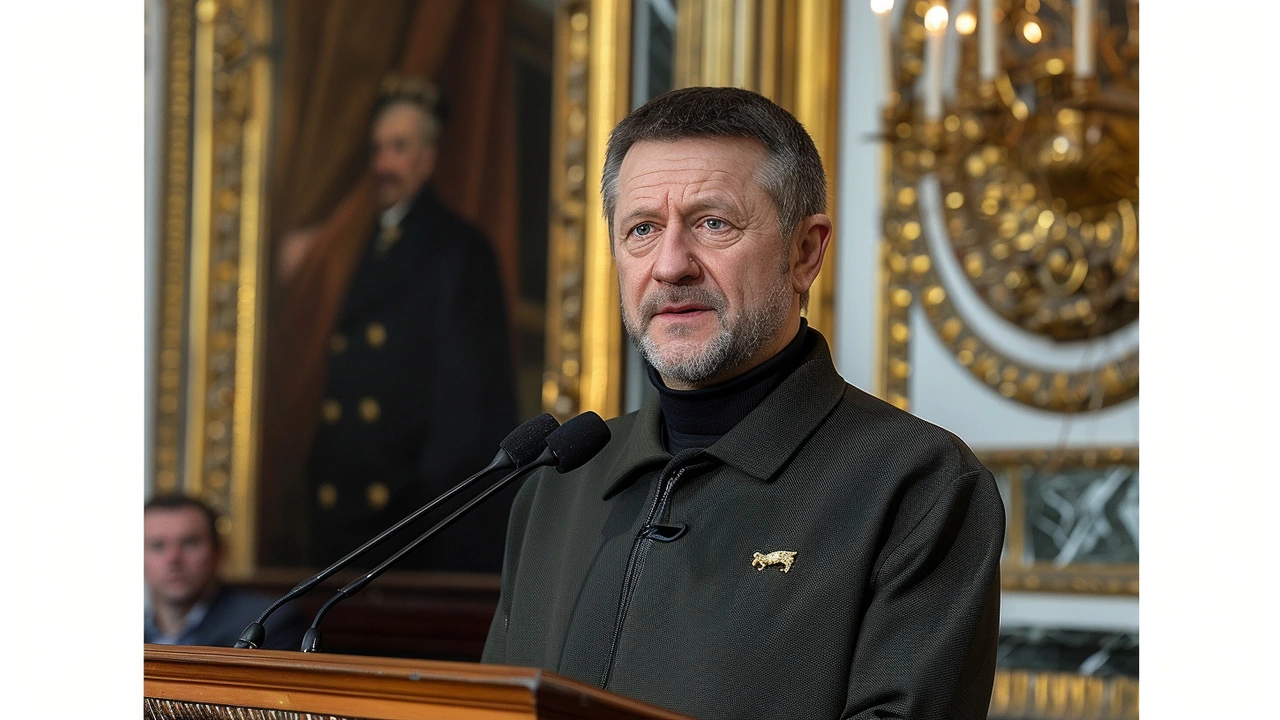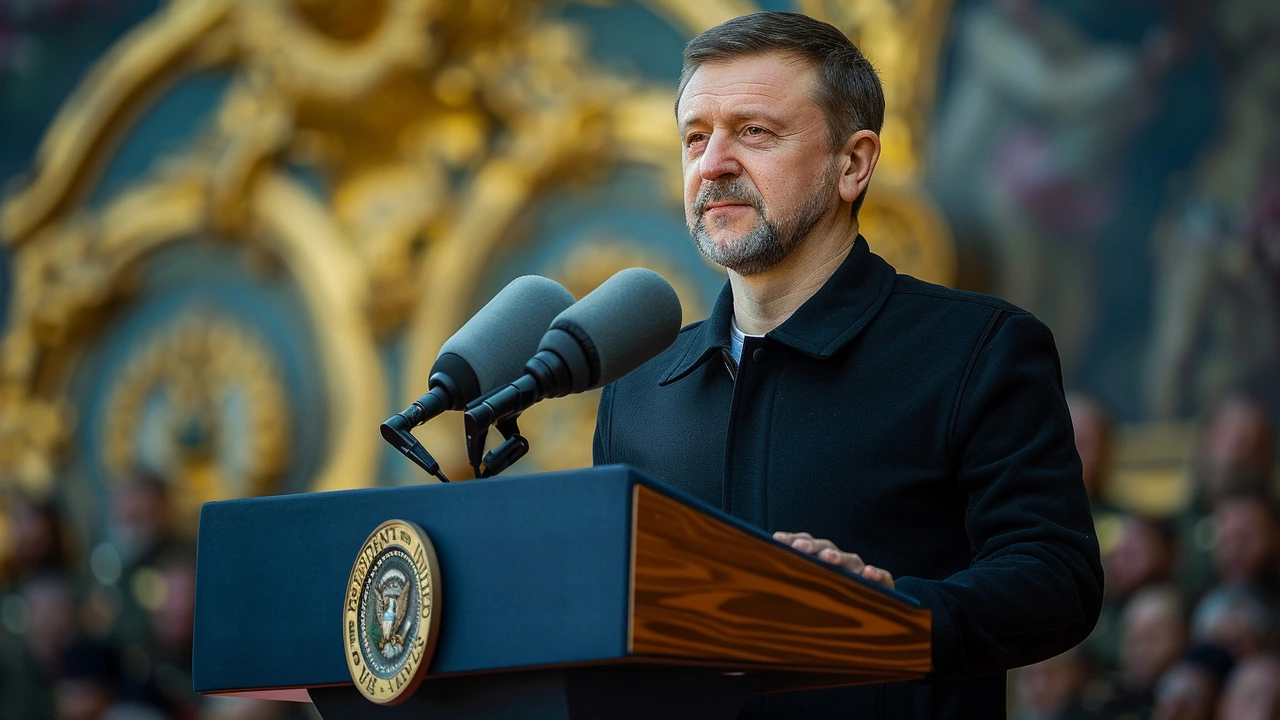
High-Stakes Meeting in Paris: Biden and Zelenskyy Discuss Military Aid
In a crucial meeting set to take place in Paris, U.S. President Joe Biden and Ukrainian President Volodymyr Zelenskyy are expected to discuss a significant $225 million military aid package aimed at bolstering Ukraine's defenses against Russian aggression. The aid package, which includes essential artillery rounds and air defense interceptors, represents a continuing commitment by the United States to support Ukraine amid the ongoing conflict.
This face-to-face discussion in Paris marks the first time Biden and Zelenskyy will meet in person since Zelenskyy's much-publicized visit to Washington D.C. in December. The importance of this meeting extends beyond mere diplomatic formalities; it underscores a tangible effort by the U.S. administration to address Ukraine's immediate defense needs, especially at a time when Ukrainian forces are actively engaged in harsh battles, particularly in the besieged Kharkiv region.
The Strategic Battlefield in Kharkiv
Kharkiv has become a focal point in the intensifying conflict, with Russian forces launching a significant offensive starting May 10. This offensive has led to the capture of several villages, escalating the urgent need for defensive measures. Ukrainian military leaders have emphasized the necessity for effective artillery and air defense systems to counter the Russian advancements effectively. The U.S.'s decision to include these particular assets in the aid package is a strategic move aimed at stabilizing the front lines in regions like Kharkiv where the fighting is most intense.
U.S. Deputy National Security Adviser Jon Finer highlighted the critical role that artillery munitions and air defense interceptors play in the broader conflict. According to Finer, these components are not just supplementary but rather essential in shifting the momentum of the war in favor of Ukrainian forces.
Western Aid and Frustrations
For Zelenskyy, this meeting with Biden is not just about receiving new military aid but also addressing broader frustrations over the pace at which Western support is materializing. Since the beginning of the invasion, Ukraine has continuously urged Western allies to expedite the delivery of much-needed military assistance; however, bureaucratic delays and complex negotiations have often slowed down the process. The U.S.'s renewed effort to send timely aid could set a precedent for other nations to follow suit, thus ensuring a more coordinated international response to Ukraine's plight.

G7 Summit: Beyond Immediate Aid
Shortly after their discussions in Paris, Biden and Zelenskyy will again converge at the G7 Summit in Italy next week. This upcoming summit is expected to extend discussions beyond immediate military aid to more long-term strategies, including the controversial use of Russian assets frozen post-invasion. There is a noteworthy proposal on the table to use these assets to provide a massive $50 billion aid package to Ukraine.
The potential policy shift constitutes a significant diplomatic endeavor, as nations must reach a consensus regarding the legal and ethical ramifications of seizing and reallocating frozen assets. However, given the scale of the humanitarian and military crisis in Ukraine, proponents argue that such measures are justified to ensure Ukraine's survival and eventual recovery.
Biden's Historical Parallels
President Biden has drawn historical parallels between the current conflict and the global fight against tyranny during World War Two. In recent speeches, Biden has categorically labeled Russian President Vladimir Putin as a 'dictator,' thus framing the Ukrainian struggle as part of a broader battle against autocracy. This narrative underscores the moral dimension of American support for Ukraine, portraying it as a continuation of the fight for freedom and democracy.

Policy Shifts and Military Strategy
Another noteworthy aspect of U.S. support lies in recent policy shifts allowing Ukraine to use American-supplied weapons against military targets inside Russia, especially those that directly support the offensive operations in Kharkiv. This represents a significant escalation in the level of support provided, reflecting a deeper commitment to resisting Russian aggression.
Moreover, the military aid package is seen as an integral part of this new policy direction. Each artillery shell and interceptor delivered carries not just material value but also symbolic weight, representing continued American resolve in supporting Ukraine through thick and thin.
International Negotiations and Consensus Building
The topic of using frozen Russian assets for Ukrainian aid is a contentious one, and negotiations are expected to be complex. Diplomatic channels are actively working to forge a consensus among Western nations, given the diverse legal frameworks and political stances involved. The goal is to present a united front at the G7 Summit, thereby solidifying international support for Ukraine.
Ultimately, these negotiations aim to balance the immediate urgency of military needs with long-term economic and political considerations. If successful, they could culminate in a robust aid package that would significantly enhance Ukraine's capacity to defend itself and recover from the ravages of war.
The Road Ahead
As Biden and Zelenskyy prepare to meet in Paris and later at the G7 Summit, the stakes could not be higher. The outcomes of these discussions have the potential to shape the trajectory of the conflict in Ukraine, influencing both the immediate battlefield dynamics and the long-term geopolitical landscape.
For Ukraine, timely and substantial support from Western allies is not just desirable but essential for survival. As the world watches these high-stakes negotiations unfold, the resilience and determination of the Ukrainian people remain a poignant reminder of what is at stake.
Stay tuned for continuous updates on these crucial meetings and their implications for the ongoing conflict in Ukraine and the broader international community.


13 Comments
It's heart‑warming to see leaders finally sit down face‑to‑face over something as consequential as Ukraine's defense.
/p>When the United States pledges $225 million in artillery and air‑defense interceptors, they're not just shipping metal; they're sending a message of solidarity.
This aid could tip the balance in Kharkiv, where every shell matters.
At the same time, the lingering frustration over delayed deliveries highlights the need for more streamlined logistics.
Let's hope this Paris meeting accelerates the process and encourages other allies to step up.
Ultimately, a unified front will be the strongest shield for Ukraine's sovereignty.
From a diplomatic standpoint, the Biden‑Zelenskyy engagement marks a pivotal moment in transatlantic cooperation.
/p>The inclusion of artillery munitions and interceptor systems in the package aligns with current operational requirements on the Eastern front.
Nevertheless, the procedural lag observed in previous aid deliveries warrants a systematic review.
Such an assessment could enhance the efficacy of future assistance initiatives.
One must appreciate the meticulous engineering behind each artillery round destined for the front lines; precision matters as much as quantity.
/p>The United States' commitment to providing interceptors is particularly commendable, given the escalating aerial threats over Kharkiv.
While the sum of $225 million may appear modest against the broader canvas of war expenditures, its impact on ground‑level morale is substantial.
Furthermore, the timing of this aid-arriving shortly before the G7 summit-could catalyze a broader coalition of support.
In sum, this development exemplifies strategic foresight blended with tangible assistance.
Ah, the ever‑so‑meticulous accounting of “heroic dollars”-how charmingly naive.
/p>One would think that a mere $225 million could magically resolve the labyrinthine logistics that have plagued the aid pipeline for months.
Yet, the reality is far more intricate, involving bureaucratic inertia and geopolitical bargaining chips.
Thus, while the gesture is aesthetically pleasing, its efficacy remains contingent upon a cascade of diplomatic concessions.
One must, therefore, temper optimism with a healthy dose of realism.
Seriously, think about who benefits when we keep sending more weapons into the mix-maybe it's the defense contractors who love a good profit spike.
/p>All the while, the real stories of civilians caught in the crossfire get buried under talk of interceptors and artillery shells.
Just saying, keep your eyes open; the narrative often hides who’s really cashing in.
Every shell counts.
/p>In the grand tapestry of conflict, each decision threads a paradox: peace promised through instruments of war.
/p>Wow!!! 😲 This meeting in Paris could be a game‑changer!!! 🙌 The sheer scale of $225 million in aid is mind‑blowing!!!
/p>And think about the Ukrainian troops finally getting the gear they desperately need!!! 💪
Let’s hope the G7 picks up the momentum and throws even more support their way!!! 🎉
Oh, absolutely, because history has shown that massive cash drops always translate to swift resolutions-sarcasm fully intended.
/p>The latest diplomatic tableau, featuring President Biden and President Zelenskyy convening in Paris, underscores a profound shift in the geopolitical chessboard.
/p>First, the allocation of $225 million toward artillery and air‑defense actuators is not merely a fiscal transaction; it is a strategic signal aimed at buttressing Ukraine's frontline resilience.
Second, the timing of this engagement, perched on the cusp of the G7 summit, amplifies its symbolic weight, suggesting that Western allies are coalescing around a unified doctrine of deterrence.
Third, the focus on Kharkiv highlights a battlefield where terrain, weather, and morale intersect, making every interceptor a potential lifeline for embattled units.
Fourth, the inclusion of advanced interceptors reflects an evolution in the conflict’s character, wherein aerial supremacy now directly influences ground operations.
Fifth, the press releases often gloss over the logistical snarls that accompany such deliveries-customs delays, transportation bottlenecks, and training deficits can dilute even the most generous aid packages.
Sixth, the domestic political calculus in the United States cannot be ignored; lawmakers balance constituency pressures with geopolitical imperatives, shaping the final size and scope of assistance.
Seventh, the prospect of tapping frozen Russian assets for a $50 billion aid pool raises thorny legal and ethical questions that demand careful deliberation.
Eighth, the narrative of “defending democracy” resonates deeply with historical parallels to World War II, a rhetorical device employed to galvanize public support.
Ninth, however, such grand analogies risk oversimplifying a complex, modern conflict that involves cyber warfare, hybrid tactics, and disinformation campaigns.
Tenth, the broader alliance structure-NATO, the EU, and bilateral partners-must harmonize their procurement processes to avoid duplication and waste.
Eleventh, the humanitarian dimension remains paramount; while military aid garners headlines, civilian aid, medical supplies, and reconstruction funds are equally vital for long‑term stability.
Twelfth, the psychological impact on Ukrainian soldiers, who now see a concrete material endorsement from a superpower, cannot be understated.
Thirteenth, the Russian response to this aid-potentially escalating offensives or diplomatic counter‑measures-will test the resolve of the Western coalition.
Fourteenth, the media’s framing of this meeting will shape public perception, influencing future budgetary allocations.
Fifteenth, in sum, this Paris summit is a microcosm of the larger struggle: a battle of resources, narratives, and wills, where every decision reverberates across continents.
Ultimately, the true measure of success will be whether Ukraine can translate this aid into sustained defensive capability and, eventually, a pathway to peace.
Looks like another round of diplomatic theater, but if the shells actually get there, it's a win for the folks on the ground.
/p>The real challenge will be keeping the supply lines moving without bureaucratic entanglements.
Still, any boost to Ukraine's air defense is a step in the right direction.
Let's see how the G7 picks up the slack.
Exactly, the logistics are the silent battle; without smooth transport, even the best‑crafted aid remains inert.
/p>We've got to keep the pressure on policymakers to cut red tape.
While the strategic calculus is undeniably complex, the human element-courageous citizens defending their homes-remains the beating heart of this conflict.
/p>When we translate policy into palpable protection on the front lines, we empower hope and resilience across the nation.
Let’s ensure that the diplomatic momentum converts into enduring security for Ukraine.